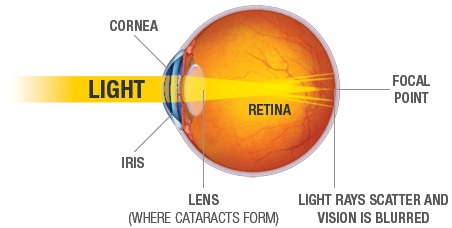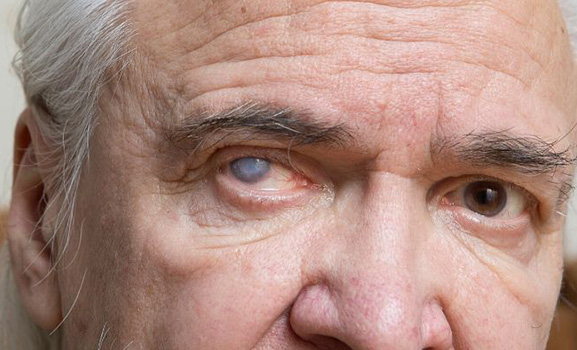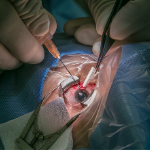What are Cataracts?
Cataracts are cloudy areas formed in the lens, which is usually transparent. They are the main reason for vision loss in people aged over 40 years. This opacification of the lens causes more vision issues globally than any other eye disease or condition, and the number is rising with the aging population. A cataract reasons a part of the lens to become cloudy or opaque. Light doesn't pass through easily, and vision becomes blurry, like looking through a fogged glass. The cloudier the lens, the worse the image will be.
Surgery is the most effective way of removing a cataract, and Dr. Oyakawa at Sharper Vision Centers offers patients the best cataracts surgery throughout the South Bay.
Symptoms of Cataracts
Cataracts can make it complex to read or drive a car, especially during the night. Seeing people's facial expressions can become hard.
They expand slowly, so most people don’t know they have cataracts at first, but as the clouding progresses, the vision gradually becomes worse. Long-distance vision is more affected at the beginning. They frequently affect both eyes, but hardly equally.
People may feel the following signs of cataracts:
- Cloudy, blurry, or misty vision;
- Vision may be affected by small dots or spots;
- Vision worsens when lights are dim;
- The patient notices small patches that blur parts of the field of vision;
- Vision is sometimes worse when there is a very bright light or glare;
- Colors appear less bright and faded;
- Reading becomes difficult and eventually impossible;
- Glasses have to be changed more frequently;
- Eventually wearing glasses becomes less efficient;
- Rarely, you may see a halo around bright objects, such as street lights or car headlights, or experience double vision in one eye.
As vision deteriorates, and the glare of street lights or oncoming headlights gets worse, driving becomes hazardous. Drivers with cataracts experience eyestrain and blink more frequently as they attempt to clear their vision.
They don’t usually change the appearance of the eye. Any discomfort such as itching, aching, redness, or irritation, is more likely caused by another eye disorder.
Cataracts aren’t hazardous to the health of the person or the eye. If they become hypermature or completely white, there may be headaches, inflammation, and some pain. Hypermature cataracts that cause pain or inflammation needs to be removed.
Schedule an appointment for an eye exam if you notice any changes in your vision. If you develop vision changes, such as flashes of light or double vision, sudden eye pain, or headache, visit your pomologist as soon as possible.
What Causes Cataracts?
Sparsely, they are present at birth or develop shortly after. They may be inherited or develop because of an infection (like rubella) in the mother during pregnancy. A cataract may also develop following eye surgery or injury for another eye condition, like glaucoma.
Most cataracts happen thanks to age-related changes in the eye's lens that cause it to become opaque or cloudy. However, other elements can contribute to cataract development, such as:
- Diabetes mellitus – People with diabetes are at higher risk for cataracts;
- Drugs – Certain medications are related to cataract development. These include: chlorpromazine, corticosteroids, and other phenothiazine-related medications;
- Ultraviolet radiation – Studies show a higher chance of cataract formation with unprotected exposure to UV radiation;
- Smoking – There is possibly a relation between smoking and increased lens cloudiness.
- Alcohol – Several studies show increased cataract formation in patients with higher alcohol consumption compared with people who have no or lower alcohol consumption.
- Nutritional deficiency – Although the results are unproven, studies suggest an association between cataract formation and low antioxidants (for example, vitamin C, vitamin E and carotenoids). Further studies may show that antioxidants can decrease cataract development.
While there are no clinically proven ways to preventing cataracts, simple preventive methods include:
- Reducing exposure to sunlight through ultraviolet blocking lenses;
- Stopping or decreasing smoking;
- Increasing (antioxidant) vitamin consumption.
Types of Cataracts
There are various types of cataracts based on where and how they develop in the eye.

- Nuclear occur in the middle of the lens and cause the nucleus, or the center, to become brown or yellow;
- Cortical are leaf-shaped and form around the edges of the nucleus;
- Posterior capsular form quicker than the other two types and affect the back of the lens;
- Congenital at birth or during a baby's first year are less common than age-related cataracts;
- Secondary are caused by medications or disease. Illnesses that are linked with the development of cataracts include diabetes and glaucoma. Taking of the steroid prednisone and other medicaments can sometimes lead to opacification of the lens;
- Traumatic develop after an eye injury, but it can take several years for this to transpire;
- Radiation can occur after a person undergoes radiation treatment for cancer.
Cataracts Treatment
The treatment for cataracts is based on the level of visual deterioration they cause. If a cataract very little affects vision, no treatment may be necessary. Patients should monitor for increased symptoms and follow a regular check-up schedule.
In some situations, changing the eyeglass prescription may provide temporary vision improvement. Additionally, anti-glare coatings on eyeglass lenses can reduce glare for night driving and raise the amount of light used when reading.
So, what is the best treatment for cataracts? When a cataract advances to the point that it affects a person’s ability to do everyday tasks, surgery may be required. It includes removing the lens of the eye and replacing it with an artificial lens. The artificial lens needs no care and can notably improve vision. Some plastic lenses feature the natural focusing ability of a young, healthy lens.
Non-Laser Cataract Surgery
Phacoemulsification is the name for traditional or non-laser cataract surgery. During non-laser cataract surgery, the surgeon uses a metal or diamond blade to manually execute the required incisions.
Your ophthalmologist creates a small incision in your cornea with a scalpel. The surgeon inserts a small instrument through this opening. It goes behind your pupil, where the eye’s lens sits in a capsule. Your eye doctor creates a round opening in the capsule. Then your ophthalmologist inserts a pen-shaped probe through that opening. The probe applies ultrasonic waves to break up the cloudy lens. Then the surgeon removes the broken-up pieces. The eye doctor replaces your lens with an artificial IOL (intraocular lens). The surgeon closes the incision with a self-seal and special liquid.

Laser-Assisted Cataract Surgery
In the course of non-laser cataract surgery, a femtosecond laser system is used instead of a blade to perform all the necessary incisions accurately.
A camera/ultrasound device will be placed over your eye to map its surface. It gathers information about your lens and sends the results to a computer that runs the laser. It tells the laser the exact location, size, and depth for incisions. The eye surgeon utilizes the laser to create the corneal incision and the opening in the capsule. The ophthalmologist may also use energy from the laser to soften the cataract. An ultrasonic probe breaks the lens into pieces and removes them. The eye doctor then puts the IOL in the eye and finishes the process.
Note – Both methods apply the same phacoemulsification technology and ultrasound waves to break up and suction out a patient’s foggy, cataract-affected natural lens.
How to Prevent Cataracts
No studies have confirmed how to prevent cataracts or slow their progression. But ophthalmologists think several strategies may be helpful, including:
- Regular eye examinations – Eye examinations can detect cataracts and other eye nuisances at their earliest stages. Ask your physician how often you should have an eye examination.
- Quit smoking – Ask your ophthalmologist for suggestions about how to stop smoking. Counseling, medications, and other strategies are available to help you.
- Manage other health issues – Follow your treatment plan if you have diabetes or other medical conditions that can up your risk of opacification of the lens;
- A healthy diet that includes vegetables and fruits – Adding a variety of healthy fruits and vegetables to your diet ensures that you're consuming many nutrients and vitamins. Vegetables and fruits have many antioxidants, which maintain the health of your eyes;
- Wear sunglasses – UV light from the sun may contribute to the development of cataracts. Wear sunglasses that block UVB rays when you're outdoors.
- Minimize alcohol use – Excessive alcohol use can increase the possibility of cataracts.
Risk Factors

Factors that increase your risk of cataracts include:
- Age;
- Diabetes;
- Obesity;
- Smoking;
- Excessive exposure to sunlight;
- Previous eye injury or inflammation;
- Previous eye surgery;
- High blood pressure;
- Consuming excessive amounts of alcohol;
- Prolonged use of corticosteroid medications.
Diagnosing Cataracts
Our Torrance ophthalmologist will do a comprehensive eye exam to check for cataracts and to assess your eyesight. This will involve an eye chart test to inspect your vision at various distances and tonometry to measure your eye pressure.
The most standard tonometry test utilizes a painless puff of air to level your cornea and check your eye pressure. Our Torrance eye doctor will also use eye drops to make the pupils bigger. Therefore, it's easier to check the optic nerve and retina at the back of your eye for damage. Other tests our ophthalmologist might perform involve checking your sensitivity to glare and your observation of colors.
Best Cataract Surgeon Torrance, CA
At SVC, we believe you deserve the best eye doctor Torrance has to offer. At each phase of cataract treatment, Dr. Oyakawa will reassess your condition and modify your treatment plan accordingly. He has considerable experience working with patients of every kind, from cataracts to complex eye conditions and from all life stages. Ray is one of few ophthalmic surgeons that is trained in vitreoretinal surgery and who can also perform both cataract and LASIK surgeries with the latest methods.
If you or your loved one have been diagnosed with a cataract, call our office at (310) 792-1010 to ask about LASIK cataract treatment today!




